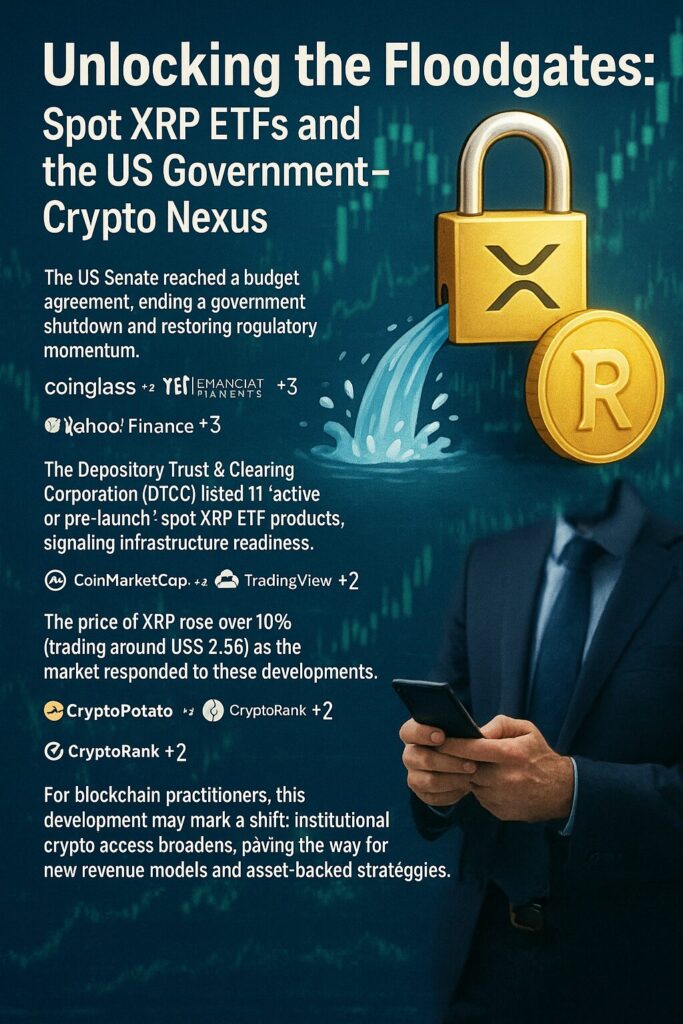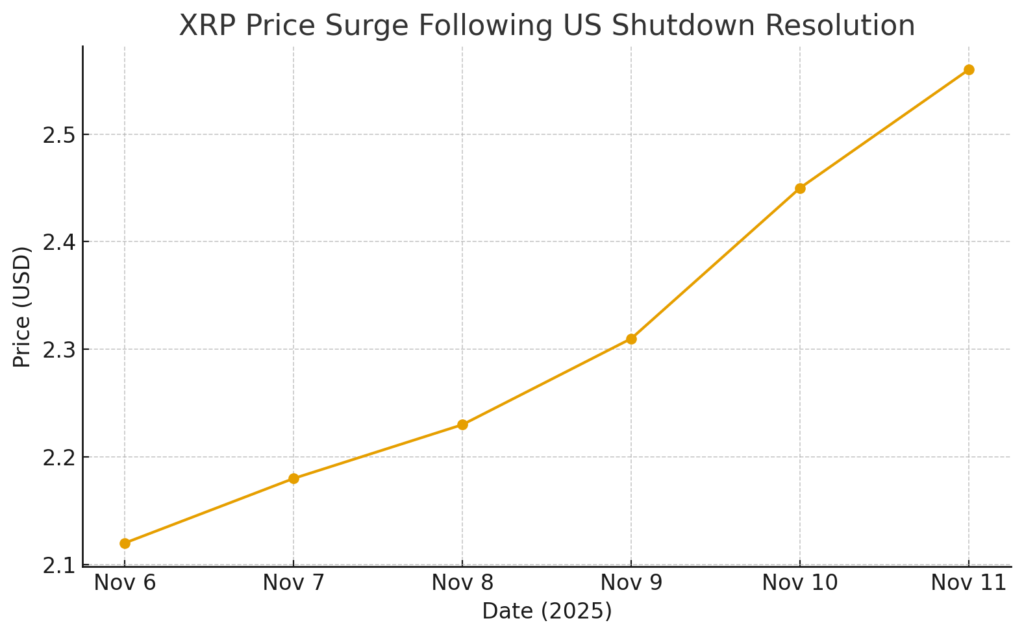
Main points :
- The US Senate reached a budget agreement, ending a government shutdown and restoring regulatory momentum.
- The Depository Trust & Clearing Corporation (DTCC) listed 11 “active or pre-launch” spot XRP ETF products, signaling infrastructure readiness.
- The price of XRP rose over 10% (trading around US$ 2.56) as the market responded to these developments.
- Analysts suggest the first spot XRP ETF under the Securities Act of 1933 could launch imminently; regulatory bottlenecks may be clearing.
- For blockchain practitioners, this development may mark a shift: institutional crypto access broadens, paving the way for new revenue models and asset-backed strategies.
1. Regulatory Reset and the Government Shutdown
The trigger for this sudden burst of momentum in the XRP market was the break in stalemate in the US Congress. With a bipartisan budget deal reportedly achieved, the risk of a prolonged government shutdown receded. During the shutdown, regulatory agencies like the U.S. Securities and Exchange Commission (SEC) had been furloughed or functioning with minimal staff, delaying review of cryptocurrency ETFs.
As regulators return to full function, crypto markets see this as a positive omen—especially for major altcoins such as XRP. The renewed capacity means that ETF filings, legal reviews and approvals could proceed quickly. This resets the timeline from regulatory gridlock back to active processing, which in turn emboldens market participants and institutional asset-managers planning crypto exposure.
For your audience—those seeking new crypto assets or looking to integrate blockchain into business or finance models—this regulatory reset matters. It suggests that the “iceberg” of crypto institutional infrastructure may start surfacing: regulated funds, legacy markets, and tokenised asset-vehicles become more plausible.
2. The DTCC Listings: Proof of Infrastructure Readiness

One of the most tangible signs that the ETF infrastructure is primed came when the DTCC published 11 listings of “spot XRP ETF” products under its “active / pre-launch” category. These include offerings from major issuers: 21Shares, ProShares, Bitwise, Canary Capital, Volatility Shares, REX‑Osprey, CoinShares, Amplify, and Franklin Templeton.
It’s worth emphasising: a DTCC listing is not the same as SEC approval. The DTCC listing means that the clearing and settlement framework is in place (tickers, internal systems, pre-launch status), which is a necessary but not sufficient step. Nonetheless, for investors and blockchain adopters alike, this signals that institutional access to XRP via regulated vehicles may be just around the corner.
From a blockchain use-case perspective, regulated ETFs for an altcoin like XRP suggests bridging between traditional finance and tokenised assets. If your project is designing token infrastructure, this may hint that the “traditional rails” layer (clearing, settlement, fund structure) is aligning with blockchain rails.
3. Price Movement & Market Reaction

As the news broke, market reaction was swift: XRP’s price surged by more than 10 % in the past 24 hours, trading around US$ 2.56 according to CoinGecko. The rally reflects both the direct speculation on ETF launches and the broader sentiment shift that regulatory constraints are loosening.
Technically speaking, this price move may represent the classic “buy the rumor, sell the news” pattern—but for investors exploring new crypto assets, it suggests that:
- The “asset” (XRP) is now being re-priced on the possibility of institutional inflows.
- If an ETF launches, liquidity and legitimacy may increase, which in turn could lower spreads, improve access, and raise usage for actual utility (such as blockchain settlement flows).
- If your strategy involves blockchain platforms that handle cross-border or institutional flows (as XRP does via the Ripple Labs ecosystem), such market events may be accelerators for adoption, not just speculation.
However, caution is warranted: price surges driven by expectation can reverse if approvals are delayed or tarnished by regulatory complications. Market structure suggests key resistance may lie ahead (analysts mention US$ 3.00-3.50 region).
4. Why This Matters for Blockchain Practitioners and Crypto Investors
For your target audience—those seeking new crypto assets, revenue sources, and practical blockchain applications—this development should be viewed through multiple lenses:
Institutional Entry / Tokenised Assets
The imminent launch of spot XRP ETFs suggests crypto is moving further into “mainstream finance”. The tokenisation of assets, the integration of digital-asset infrastructure with clearing and settlement systems (like the DTCC), and the regulatory green lights all point toward a convergence of blockchain and tradfi. If you are building or designing blockchain solutions (e.g., your project ‘dzilla Wallet’ mentioned earlier), this is an opportune moment to integrate institutional-ready features: custody, compliance, token-to-token swaps, regulated access.
Revenue and Yield Opportunities
With ETFs creating on-ramps, liquidity may increase—and with liquidity comes revenue opportunities. For example:
- Platforms may offer token access or swaps between XRP and other assets.
- Wallets and DeFi/DEX tools may capture flows as institutions tap ETFs then engage in underlying token operations.
- Infrastructure providers might see demand for fund flows, custody services, settlement layers, and blockchain integrations.
Blockchain Use-Case Validation
By obtaining regulated ETF status, XRP’s underlying network and ledger may gain further legitimacy beyond speculative trading. If institutional participants engage with XRP at scale, it may reinforce the value of the ledger in cross-border settlement or payment rails. For blockchain practitioners, this is a signal: the layer-1 asset is matching infrastructure bridging token-economy to legacy finance.
Risk and Timing Considerations
- The approvals are expected but not confirmed; any delay could trigger a reversal of sentiment.
- Even once ETFs launch, the full inflow may take time—so short-term price action may be volatile.
- For those building applications, focusing solely on one asset (XRP) may limit flexibility; the broader trend is “tokenisation plus regulated rails”, not just one coin.
- For revenue models, capturing institutional flows requires compliance, custody, security, and transparency—so readiness matters more than hype.
5. Recent Moves and What to Watch
Looking at deeper details beyond the headline:
- Several issuers amended their ETF filings to remove “delaying amendments” and trigger automatic effectiveness periods—this suggests launch dates may be within weeks.
- Analytical reports note that while price is rallying, profit realisation by XRP holders increased—suggesting distribution or “taking off” at current levels rather than solely accumulation.
- As the US shutdown risk faded, open interest in crypto futures and institutional derivatives reportedly rose—showing positioning ahead of ETF launches.
For your project or investment strategy, the key metrics to monitor in the coming days/weeks will include:
- Official SEC approval announcements for spot XRP ETFs.
- Fund launch dates, ticker listings, and initial volumes.
- Inflow numbers into the ETF vehicles (once live).
- On-chain metrics for XRP: volume, active addresses, large holder accumulation.
- Network utility measures: settlement volume on XRP ledger, usage for cross-border transfers.
- Competitive altcoins: how similar assets (e.g., SOL, ADA) respond to ETF-infrastructure shifts and whether they catch up.
6. Strategy Implications & How to Act
Here are actionable points for your audience:
- If you are evaluating XRP as a strategic asset: consider that upcoming ETF launch could shift the risk-reward profile — both upside (institutional access) and downside (if the launch is delayed).
- If you are building blockchain infrastructure (wallets, swaps, custody): prepare for increased institutional access flows—ensure compliance features, integration with fund vehicles, token swap capabilities (such as your BTC → ETH swap design) are ready.
- If you target new crypto revenue sources: look for ancillary services around ETFs (custody, settlement, token integration) rather than solely asset price appreciation.
- Maintain flexibility: while XRP is currently leading this wave, the broader trend is infrastructure-ready tokenisation—so stay agnostic to assets, focus on layers.
- Risk-management: monitor regulatory announcements closely; have stop-loss or hedging strategies in place if sentiment reverses.

Conclusion
In sum, the convergence of a US government-shutdown resolution, DTCC listings of spot XRP ETFs, and the surge in XRP price signals a potential structural shift in the crypto-asset landscape. For investors seeking new assets, for blockchain practitioners building practical applications, and for platforms designing token swap flows, the moment represents more than hype: it is about institutional access, reg-rail alignment, and the tokenised-asset era stepping into mainstream finance.
If the first spot XRP ETF under the 1933 Act launches this week as anticipated, then the “floodgates” of crypto-ETFs may open beyond Bitcoin and Ethereum—accelerating revenue opportunities and real-world utility for token networks. At the same time, timing and readiness matter: this is not just about buying a token, but about building infrastructure and workflows to capture the next wave.

